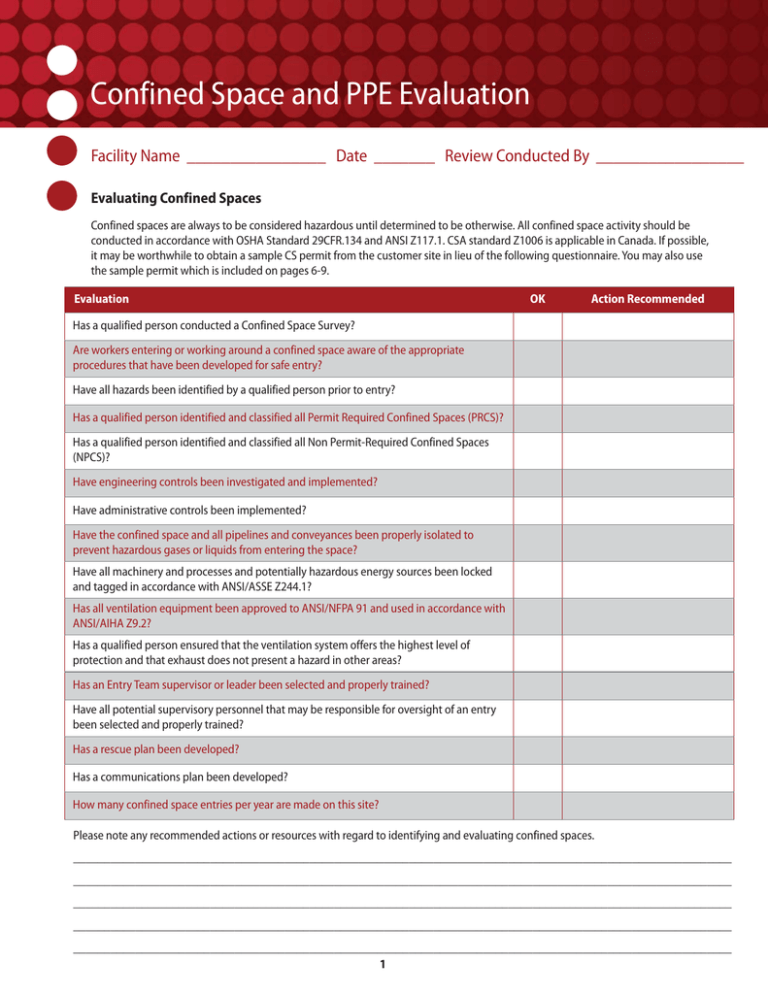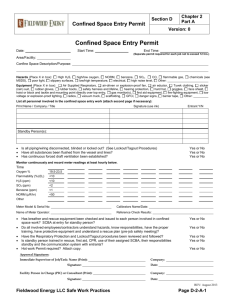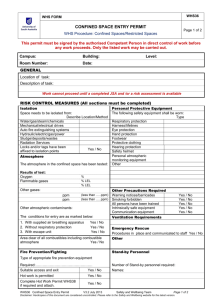Confined Space and PPE Evaluation
advertisement

Confined Space and PPE Evaluation Facility Name ________________ Date _______ Review Conducted By _________________ Evaluating Confined Spaces Confined spaces are always to be considered hazardous until determined to be otherwise. All confined space activity should be conducted in accordance with OSHA Standard 29CFR.134 and ANSI Z117.1. CSA standard Z1006 is applicable in Canada. If possible, it may be worthwhile to obtain a sample CS permit from the customer site in lieu of the following questionnaire. You may also use the sample permit which is included on pages 6-9. Evaluation OK Action Recommended Has a qualified person conducted a Confined Space Survey? Are workers entering or working around a confined space aware of the appropriate procedures that have been developed for safe entry? Have all hazards been identified by a qualified person prior to entry? Has a qualified person identified and classified all Permit Required Confined Spaces (PRCS)? Has a qualified person identified and classified all Non Permit-Required Confined Spaces (NPCS)? Have engineering controls been investigated and implemented? Have administrative controls been implemented? Have the confined space and all pipelines and conveyances been properly isolated to prevent hazardous gases or liquids from entering the space? Have all machinery and processes and potentially hazardous energy sources been locked and tagged in accordance with ANSI/ASSE Z244.1? Has all ventilation equipment been approved to ANSI/NFPA 91 and used in accordance with ANSI/AIHA Z9.2? Has a qualified person ensured that the ventilation system offers the highest level of protection and that exhaust does not present a hazard in other areas? Has an Entry Team supervisor or leader been selected and properly trained? Have all potential supervisory personnel that may be responsible for oversight of an entry been selected and properly trained? Has a rescue plan been developed? Has a communications plan been developed? How many confined space entries per year are made on this site? Please note any recommended actions or resources with regard to identifying and evaluating confined spaces. __________________________________________________________________________________________________________ __________________________________________________________________________________________________________ __________________________________________________________________________________________________________ __________________________________________________________________________________________________________ __________________________________________________________________________________________________________ 1 Atmospheric Testing/Detection Has a qualified person identified all specific atmospheric contamination that can be in a confined space prior to entry? Note: Hazards should be identified in advance to determine the appropriate methods and equipment to be used in various emergency retrieval or rescue scenarios. Testing/Detection OK Action Recommended Number Brand - Model What is the age of all of your instruments? Have all gases that are to be monitored been identified by a qualified person and have all possible gases and interference gases been identified? Has all of the gas detection equipment been properly calibrated or bump tested prior to use? Has it been determined if additional protective gas detection or individually issued detectors are needed by all entering a confined space? How are you doing your calibration? What is your deepest and longest confined space? What is the duration of your longest confined space entry? Is all calibration gas within date code and in concentrations specified by the manufacturer? Detectors/Instrumentation Used 5 Gas Detector – Pumped 4 Gas Detector – Diffusion or Pumped Single Gas Detector Remote probe Calibration system Please note any recommended actions or resources for this site with regard to its Testing/Detection program. __________________________________________________________________________________________________________ __________________________________________________________________________________________________________ __________________________________________________________________________________________________________ __________________________________________________________________________________________________________ __________________________________________________________________________________________________________ 2 Respiratory Protection All respirators must be NIOSH approved and a respiratory protection program must be implemented in accordance with OSHA 29 CFR 1910.134 or CSA Z94.1 (Canada). All rescue personnel are required to use NIOSH approved SCBA or Type-C combination SAR with escape cylinder. In addition, all entrants must use SCBA or Type-C Combination SAR with escape when entering an IDLH environment. Respiratory Protection OK Action Recommended Number Brand - Model Has a written respiratory protection program been prepared by a qualified person in accordance with proper standards? Has a hazard assessment been completed and have all respirators and cartridges been selected according to hazards, exposure limits, and assigned protection factors? Have all personnel been properly fit-tested annually for the respirators in use? Are all persons who will use respirators medically cleared to do so? Have all SCBA and combination units been flow-tested at required intervals? Are all SCBA/Escape Unit air cylinders within their operating life and hydrostatically tested at proper intervals per DOT requirements? Are all air cylinders charged to the proper fill pressure? Is there any visible deterioration, heat, flame or other damage to the harness and are the harness straps fully open? Are all units stored in a clean, dry, cool space and out of direct sunlight with a proper wall case, bracket or hard case? What is your source of Grade D breathing air for SCBA or Air Lines? What is your procedure for cleaning, inspection and maintenance of respirators and facepieces? Do you have a cartridge change-out schedule? - if applicable. Respirators Used Non-NFPA SCBA NFPA SCBA Combination SAR/Escape Units APR Half-Masks APR Full-Face Escape-Only Devices Please note any recommended actions or resources for this site with regard to its Respiratory Protection program. __________________________________________________________________________________________________________ __________________________________________________________________________________________________________ __________________________________________________________________________________________________________ __________________________________________________________________________________________________________ __________________________________________________________________________________________________________ 3 Entry – Fall Protection and Arrest Fall Protection OK Action Recommended Number Brand - Model Is all equipment stored in a clean, dry, cool space? Are all harnesses within the shelf life recommended by the manufacturer? Has all fall protection equipment been inspected by a competent person in the past 2 months or less (6 months for Construction applications)? Have all workers received Fall Protection and rescue training ? Have all personnel been properly fitted for a full body harness? Does each harness have the appropriate attachment points for fall arrest, personnel-riding, and rescue? Is a tripod or davit appropriate for the specific confined space? Is portability of davits important? Is there enough clearance for the tripod to fit over the entrance without risk of one of the feet coming too close to the confined space opening? Is there enough space around the confined space opening to ensure that top-side attendants are safe from falling into the opening? Does the confined space have a ladder in place or is a hoist/winch needed? What is the maximum line length needed within the confined space to complete the task? Are you equipped for entry rescue – if included in your rescue plan? Does your equipment allow for non-entry rescue and is all equipment matched to your rescue plan? Do you have a method of tracking all equipment? Fall Protection Equipment Used Full Body Harness Bosun Chair Tripod/Davit Self Retracting Lanyard with retrieval capabilities Hoist/Winch Rescue Utility System Anchors Please note any recommended actions or resources for this site with regard to its Entry/Fall Protection program. __________________________________________________________________________________________________________ __________________________________________________________________________________________________________ __________________________________________________________________________________________________________ __________________________________________________________________________________________________________ __________________________________________________________________________________________________________ 4 Personal Protective Equipment & Communications Personal Protective Equipment & Communications OK Action Recommended Number Brand - Model What are your primary methods of communication between attendants and entrants? (Line of sight, hand signals, radio, air horn, PASS device) Are all protective clothing or suits rated to hazards expected to be encountered? Have all personnel been properly trained on helmet inspection? Does the entire head- and face-protection ensemble represent a system that was tested together to ensure compliance with ANSI/ISEA Z87.1-2010? Are personnel wearing safety eyewear in addition to face-shields to ensure primary eye protection? Are all personnel fitted with application-appropriate hearing protection? Has a radio or other communication protocol been established? Are all radio batteries charged and is there a standard maintenance program? Are all radios rated as intrinsically safe? Has all radio equipment been tested to work in the confined space? Is all lighting equipment adequate and properly maintained? PPE Used Hard Hats Hearing protection, plugs and or muffs Radio interface, HCS/Clear command Radio Type Communications sets Please note any recommended actions or resources for this site with regard to its PPE and Communications program. __________________________________________________________________________________________________________ __________________________________________________________________________________________________________ __________________________________________________________________________________________________________ __________________________________________________________________________________________________________ __________________________________________________________________________________________________________ 5 Appendix D to OSHA 29 CFR §1910.146 – Sample Permit Appendix D-1 Confined Space Entry Permit Date and Time Issued: ________________________ Date and Time Expires: _____________________ Job site/Space I.D.: ___________________________ Job Supervisor:___________________________ Equipment to be worked on: ___________________ Work to be performed: _____________________ 1. Atmospheric Checks: Time ________ Oxygen ________% Explosive ________% LEL Toxic ________PPM 2. Tester's signature: __________________________________________________ 3. Source isolation (No Entry): Pumps or lines blinded, disconnected, or blocked 4. Ventilation Modification: Mechanical Natural Ventilation only N/A Yes No () () () N/A Yes No () () () () () () 5. Atmospheric check after Isolation and Ventilation: Oxygen ___________% > 19.5% Explosive ___________% LEL < 10% Toxic ___________PPM < 10 PPM H(2)S Time ___________ Tester’s signature: __________________________________________________ 6. Communication procedures: _________________________________________________________ __________________________________________________________________________________ 7. Rescue procedures: _________________________________________________________________ __________________________________________________________________________________ __________________________________________________________________________________ 8. Entry, standby, and back up persons: Successfully completed required training? Is it current? Yes () () 6 No () () 9. Equipment: Direct reading gas monitor - tested Safety harnesses and lifelines for entry and standby persons Hoisting equipment Powered communications SCBA for entry and standby persons Protective Clothing All electric equipment listed Class I, Division I, Group D and Non-sparking tools 10. Periodic atmospheric tests: Oxygen ____% Time Oxygen ____% Time Explosive ____% Time Explosive ____% Time Toxic ____% Time Toxic ____% Time ____ ____ ____ ____ ____ ____ Oxygen Oxygen Explosive Explosive Toxic Toxic ____% ____% ____% ____% ____% ____% Time Time Time Time Time Time N/A () () () () () () () Yes () () () () () () () No () () () () () () () ____ ____ ____ ____ ____ ____ We have reviewed the work authorized by this permit and the information contained here-in. Written instructions and safety procedures have been received and are understood. Entry cannot be approved if any items are marked in the "No" column. This permit is not valid unless all appropriate items are completed. Permit Prepared By: (Supervisor) _____________________________________________________________ Approved By: (Unit Supervisor) ______________________________________________________________ Reviewed By (CS Operations Personnel) : _________________________ ____________________________ (printed name) (signature) This permit to be kept at job site. Return job site copy to Safety Office following job completion. Copies: White Original (Safety Office) Yellow (Unit Supervisor) Hard (Job site) Appendix D-2 Entry Permit Permit Valid for 8 Hours Only. All copies of permit will remain at job site until job is completed. Date: ____ - ____ - ____ Site Location and Description: ___________________________________________ Purpose of Entry: ____________________________________________________________________________ Supervisor(s) in charge of crews: ______________________ Type of crew: ______________________________ Phone Number: _______________________________ Communication Procedures: ___________________________________________________________________ _________________________________________________________________________________________ Rescue Procedures (phone numbers at bottom): ____________________________________________________ _________________________________________________________________________________________ 7 *Bold denotes minimum requirements to be completed reviewed prior to entry* Requirements Completed Lock Out/De-energize/Tag-out Line(s) Broken-Capped-Blanked Purge-Flush and Vent Ventilation Secure Area (Post and Flag) Breathing Apparatus Resuscitator - Inhalator Standby Safety Personnel Full Body Harness w/D- ring Emergency Escape Retrieval Equipment Lifelines Fire Extinguishers Lighting (Explosive Proof) Protective Clothing Respirator(s) (Air-Purifying) Burning and Welding Permit Date ________ ________ ________ ________ ________ ________ ________ ________ ________ ________ ________ ________ ________ ________ ________ ________ Time ________ ________ ________ ________ ________ ________ ________ ________ ________ ________ ________ ________ ________ ________ ________ ________ Note: Items that do not apply enter N/A in the blank. **Record continuous monitoring results every 2 hours** Permissible: ________________________________________________________________________________ Tests to be taken Percent of Oxygen Lower Flammable Limit Carbon Monoxide Aromatic Hydrocarbon Hydrogen Cyanide Hydrogen Sulfide Sulfur Dioxide Ammonia 19.5% to 23.5% Under 10% +35 PPM +1 PPM * 5 PPM (Skin) * 4 PPM +10 PPM * 15 PPM +2 PPM * 5 PPM * 35 PPM _____ _____ _____ _____ _____ _____ _____ _____ _____ _____ _____ _____ _____ _____ _____ _____ _____ _____ _____ _____ _____ _____ _____ _____ Entry Level _____ _____ _____ _____ _____ _____ _____ _____ _____ _____ _____ _____ _____ _____ _____ _____ _____ _____ _____ _____ _____ _____ _____ _____ _____ _____ _____ _____ _____ _____ _____ _____ _____ _____ _____ _____ _____ _____ _____ _____ * Short-term exposure limit: Employee can work in the area up to 15 minutes. + 8 hr. Time Weighted Avg.: Employee can work in area 8 hrs (longer with appropriate respiratory protection). Remarks: ________________________________________________________________________________ Gas tester name Check # _______________ ______ _______________ ______ Instrument(s) used _________________ _________________ Model and/or type _________________ _________________ Serial and/or unit # ________________ ________________ Safety Standby Person is required for all confined space work. Safety Standby Check # Person _________________ ______ _________________ ______ Confined Space Check# Entrant (s) ___________________ ______ ___________________ ______ Confined Space Check# Entrant (s) __________________ ______ __________________ ______ Supervisor authorizing – all conditions satisfied _____________________________________________________ Department phone # _________________________________________________________________________ AMBULANCE ______________ • FIRE ______________ • Safety _____________ • Gas Coordinator ____________ ID 5555-533-MC / May 2011 © MSA 2011 Printed in U.S.A. 8

